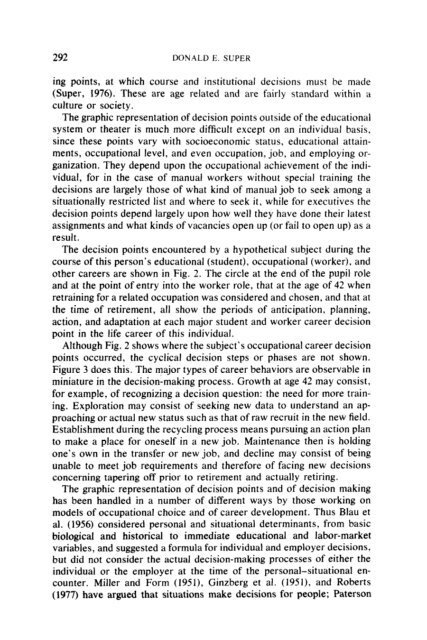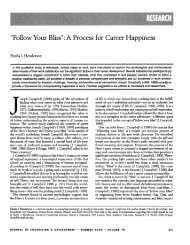A Life-Span, Life-Space Approach to Career Development
A Life-Span, Life-Space Approach to Career Development
A Life-Span, Life-Space Approach to Career Development
You also want an ePaper? Increase the reach of your titles
YUMPU automatically turns print PDFs into web optimized ePapers that Google loves.
292 DONALD E. SUPER<br />
ing points, at which course and institutional decisions must be made<br />
(Super, 1976). These are age related and are fairly standard within a<br />
culture or society.<br />
The graphic representation of decision points outside of the educational<br />
system or theater is much more difficult except on an individual basis,<br />
since these points vary with socioeconomic status, educational attain-<br />
ments, occupational level, and even occupation, job, and employing or-<br />
ganization. They depend upon the occupational achievement of the indi-<br />
vidual, for in the case of manual workers without special training the<br />
decisions are largely those of what kind of manual job <strong>to</strong> seek among a<br />
situationally restricted list and where <strong>to</strong> seek it, while for executives the<br />
decision points depend largely upon how well they have done their latest<br />
assignments and what kinds of vacancies open up (or fail <strong>to</strong> open up) as a<br />
result.<br />
The decision points encountered by a hypothetical subject during the<br />
course of this person’s educational (student), occupational (worker), and<br />
other careers are shown in,Fig. 2. The circle at the end of the pupil role<br />
and at the point of entry in<strong>to</strong> the worker role, that at the age of 42 when<br />
retraining for a related occupation was considered and chosen, and that at<br />
the time of retirement, all show the periods of anticipation, planning,<br />
action, and adaptation at each major student and worker career decision<br />
point in the life career of this individual.<br />
Although Fig. 2 shows where the subject’s occupational career decision<br />
points occurred, the cyclical decision steps or phases are not shown.<br />
Figure 3 does this. The major types of career behaviors are observable in<br />
miniature in the decision-making process. Growth at age 42 may consist,<br />
for example, of recognizing a decision question: the need for more train-<br />
ing. Exploration may consist of seeking new data <strong>to</strong> understand an ap-<br />
proaching or actual new status such as that of raw recruit in the new field.<br />
Establishment during the recycling process means pursuing an action plan<br />
<strong>to</strong> make a place for oneself in a new job. Maintenance then is holding<br />
one’s own in the transfer or new job, and decline may consist of being<br />
unable <strong>to</strong> meet job requirements and therefore of facing new decisions<br />
concerning tapering off prior <strong>to</strong> retirement and actually retiring.<br />
The graphic representation of decision points and of decision making<br />
has been handled in a number of different ways by those working on<br />
models of occupational choice and of career development. Thus Blau et<br />
al. (1956) considered personal and situational determinants, from basic<br />
biological and his<strong>to</strong>rical <strong>to</strong> immediate educational and labor-market<br />
variables, and suggested a formula for individual and employer decisions,<br />
but did not consider the actual decision-making processes of either the<br />
individual or the employer at the time of the personal-situational en-<br />
counter. Miller and Form (1951), Ginzberg et al. (1951), and Roberts<br />
(1977) have argued that situations make decisions for people; Paterson



